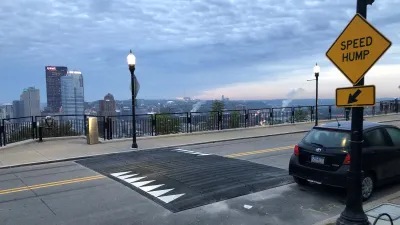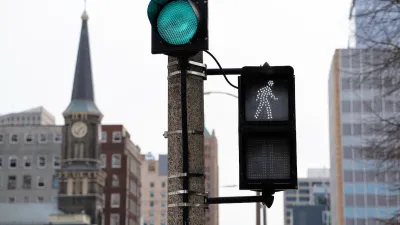The city’s traffic calming initiative has led to a 6 percent average reduction in speeds on corridors with recent interventions.

Pittsburgh’s “Community-driven. Block-by-block. Low cost” traffic calming effort could serve as a useful model for other cities, writes Asia Mieleszko in the Strong Towns journal.
The city focused on quick-build interventions to slow traffic and improve safety on streets nominated by residents as needing more safety measures. “These include raised crosswalks, pedestrian islands, changes to lane widths, chicanes, and most popularly, speed cushions.”
The program has had significant impacts: “On a 1,000-foot segment of Seagirt Street between Nimick Place to Bennett Street the average speed has dropped 13 miles, from 36 to 23 miles per hour, after the installation of speed humps.” The average drop in speed on streets with new traffic calming is 6 miles per hour.
The city’s Department of Mobility and Infrastructure (DOMI) uses discretionary funding for the projects. “Too often, communities feel stuck—waiting for funding, plans, or approvals while dangerous conditions persist. But Pittsburgh proves don’t need a massive budget or a multi-year capital plan to begin making change.”
FULL STORY: Pittsburgh's Low-Cost Traffic Calming Is a Model for Every City

Planetizen Federal Action Tracker
A weekly monitor of how Trump’s orders and actions are impacting planners and planning in America.

Map: Where Senate Republicans Want to Sell Your Public Lands
For public land advocates, the Senate Republicans’ proposal to sell millions of acres of public land in the West is “the biggest fight of their careers.”

Restaurant Patios Were a Pandemic Win — Why Were They so Hard to Keep?
Social distancing requirements and changes in travel patterns prompted cities to pilot new uses for street and sidewalk space. Then it got complicated.

Platform Pilsner: Vancouver Transit Agency Releases... a Beer?
TransLink will receive a portion of every sale of the four-pack.

Toronto Weighs Cheaper Transit, Parking Hikes for Major Events
Special event rates would take effect during large festivals, sports games and concerts to ‘discourage driving, manage congestion and free up space for transit.”

Berlin to Consider Car-Free Zone Larger Than Manhattan
The area bound by the 22-mile Ringbahn would still allow 12 uses of a private automobile per year per person, and several other exemptions.
Urban Design for Planners 1: Software Tools
This six-course series explores essential urban design concepts using open source software and equips planners with the tools they need to participate fully in the urban design process.
Planning for Universal Design
Learn the tools for implementing Universal Design in planning regulations.
Heyer Gruel & Associates PA
JM Goldson LLC
Custer County Colorado
City of Camden Redevelopment Agency
City of Astoria
Transportation Research & Education Center (TREC) at Portland State University
Camden Redevelopment Agency
City of Claremont
Municipality of Princeton (NJ)





























